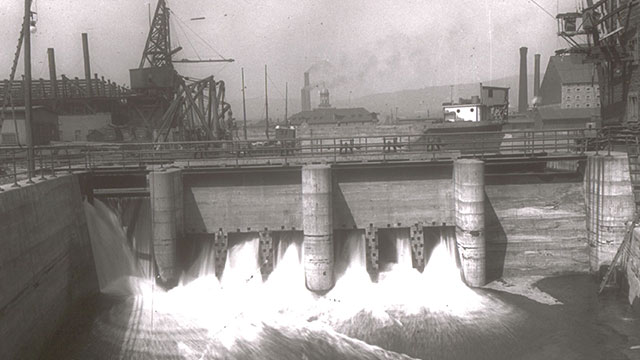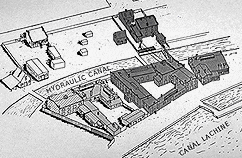
The Saint-Gabriel sector in 1920. The drained canal reveals the factory water intakes. © National Archives of Canada / PA-119396.
A supplier of hydraulic power
Lachine Canal National Historic Site
A new source of energy
At the beginning of the 19th century, industrial production occurred on a small scale, relying on manual labour or animal strength. Businesses using hydraulic energy were dependent on their water source, often located in rural areas. Finally, a few rare industries relied on steam engines, a very recent invention.
A new source of energy became available with the first reconstruction of the Lachine Canal from 1843 to 1848. The widening of the canal considerably increased the flow. The water held back upstream from the locks could be canalized and used to turn wheels or water turbines. The energy produced was made available for industries by renting hydraulic lots.
These lots neighboured on areas where the canal presents significant relative changes in elevation, namely in the vicinity of the Saint-Gabriel and Côte-Saint-Paul locks. A total of 20 lots with a 24-m façade occupy the entire south side of the basin upstream of the port of Montréal's locks. The relative change in elevation is seven metres. At both the Saint-Gabriel and Côte-Saint-Paul locks, the denivellation reaches about 2.5 m.
Energy: for whom and for what?

The hydraulic lots and the energy produced by the canal were attributed according to various formulas. From 1846 to 1851, the 20 lots in Basin No. 2 were sold by public auction. Flour milling and the iron industry dominated this sector.
At Saint-Gabriel, influential businessmen obtained a monopoly over hydraulic power. A complete network of headrace and tailrace canals was built on both sides of the canal to maximize the use of water power. Traditional businesses related to wood, iron and wheat were preponderant although they stood alongside a few newcomers in the fields of tool manufacturing, and rubber and cotton processing.

Finally, the Côte-Saint-Paul site, located in the open country at that time, was the last to be occupied. In 1853, the government conceded all hydraulic power to William Parkyn, who built a real "industrial park". After sinking his fortune into the project, Parkyn sold his rights to Frothingham and Workman, a large hardware business that set the tone for the activities in this sector- tool making.
A catalyst for industrialization
Since its advent in 1846, the canal's hydraulic power was used for dozens of businesses. According to the current state of knowledge, 13 flour mills and grain elevators, 23 nail factories, 14 edge tool industries, and 18 sawmills and wood shops have been inventoried. In 1887, at the height of their activities, these businesses employed at least 2000 workers. They consumed more energy than that produced by the first hydraulic canal built in Niagara Falls in 1895.
Thanks to the Lachine Canal, hydraulic power became available in Montréal around the middle of the 19th century, at a time when industrial production was being established in North America. It is one of the many factors that allowed the metropolis to develop from trading to industrialization, while enabling it to take the lead over other Canadian cities.
- Date modified :